Report on UK Employment Law and Company Law: Key Aspects
VerifiedAdded on 2023/06/09
|9
|2719
|308
Report
AI Summary
This report provides an overview of the employment and company law in the United Kingdom. It examines the historical structure of the UK Employment Rights Act, discussing whether it favors employers or employees, and outlines the fundamental features of company formation in the UK, includi...
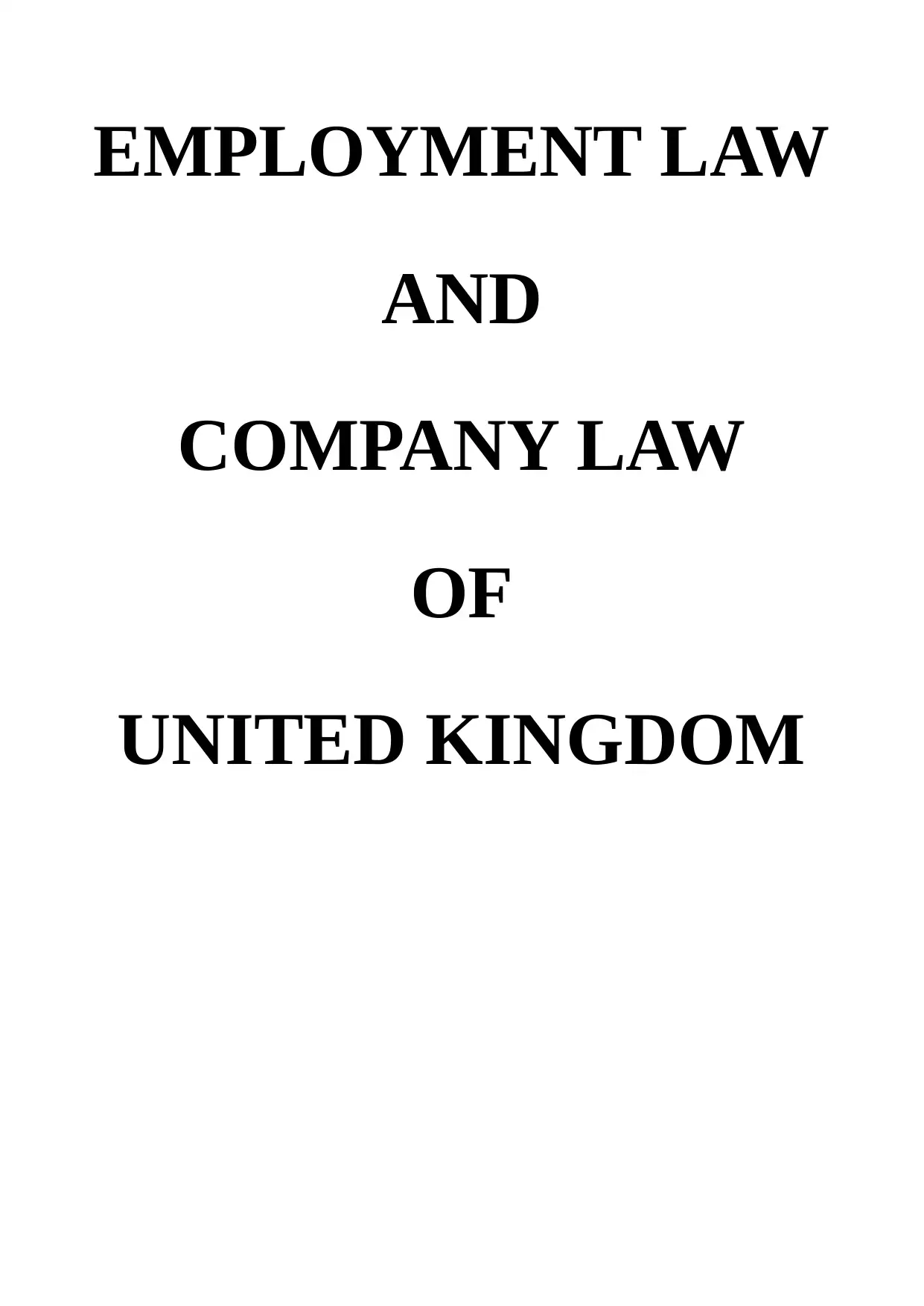
EMPLOYMENT LAW
AND
COMPANY LAW
OF
UNITED KINGDOM
AND
COMPANY LAW
OF
UNITED KINGDOM
Paraphrase This Document
Need a fresh take? Get an instant paraphrase of this document with our AI Paraphraser
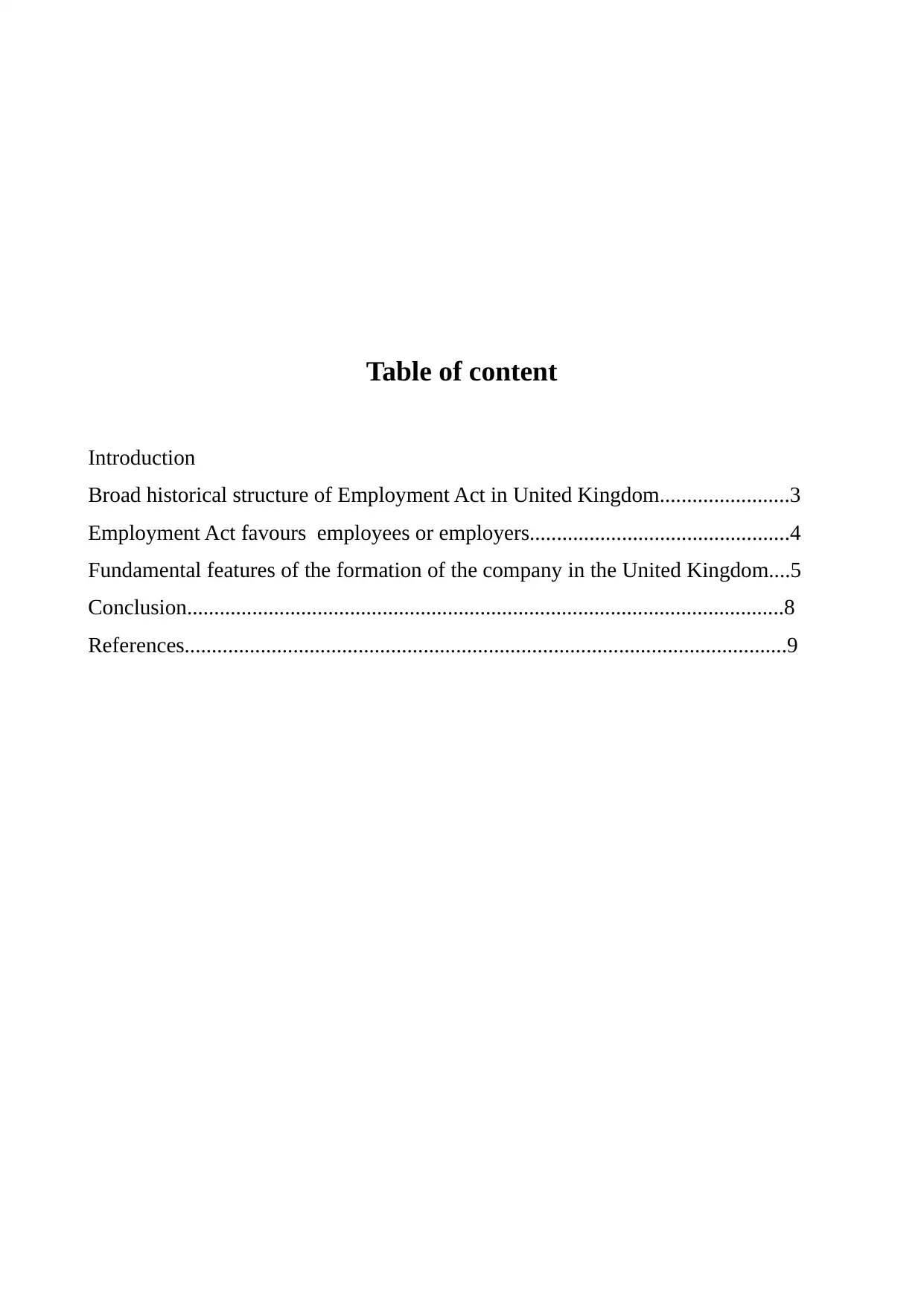
Table of content
Introduction
Broad historical structure of Employment Act in United Kingdom........................3
Employment Act favours employees or employers................................................4
Fundamental features of the formation of the company in the United Kingdom....5
Conclusion..............................................................................................................8
References...............................................................................................................9
Introduction
Broad historical structure of Employment Act in United Kingdom........................3
Employment Act favours employees or employers................................................4
Fundamental features of the formation of the company in the United Kingdom....5
Conclusion..............................................................................................................8
References...............................................................................................................9
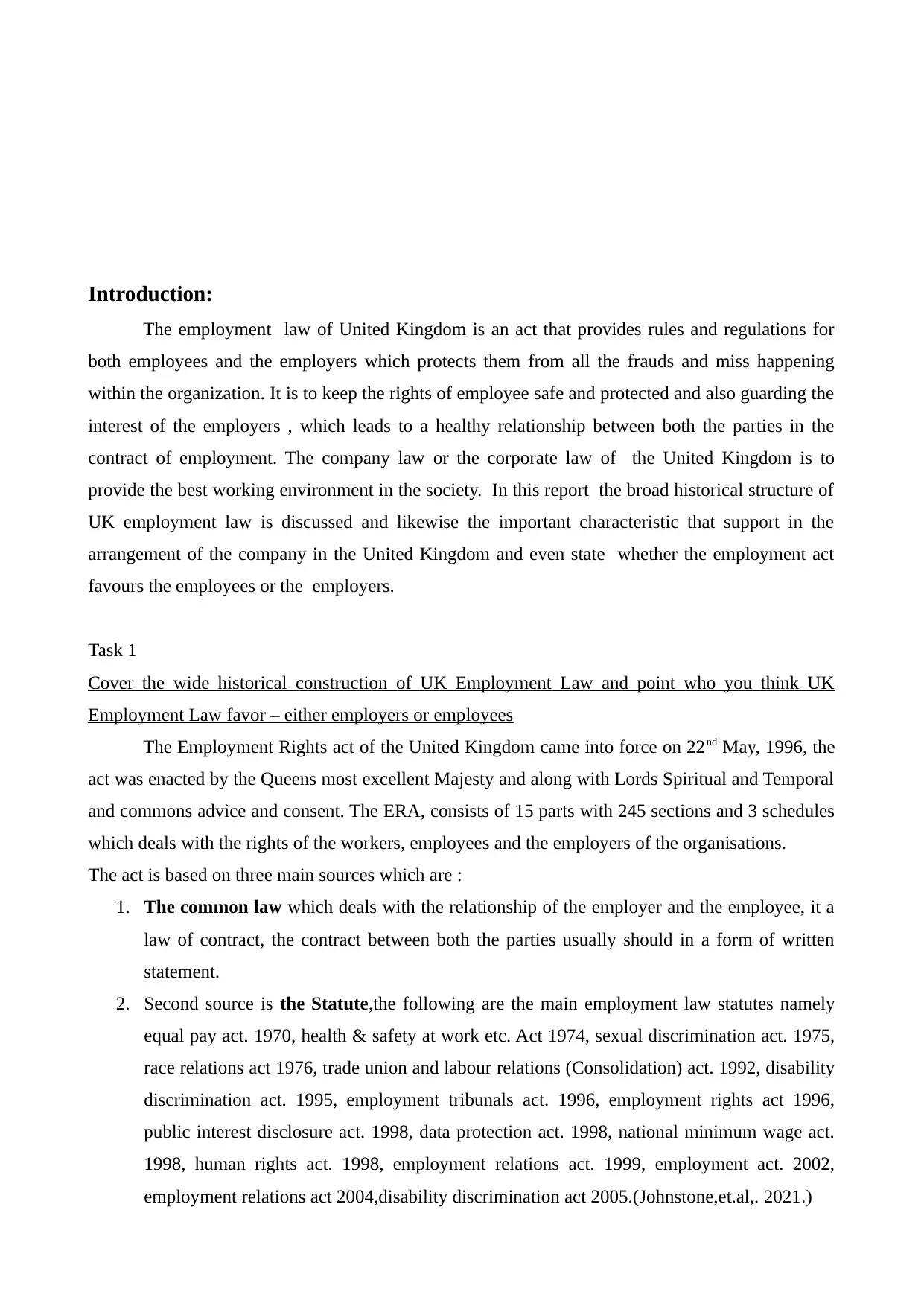
Introduction:
The employment law of United Kingdom is an act that provides rules and regulations for
both employees and the employers which protects them from all the frauds and miss happening
within the organization. It is to keep the rights of employee safe and protected and also guarding the
interest of the employers , which leads to a healthy relationship between both the parties in the
contract of employment. The company law or the corporate law of the United Kingdom is to
provide the best working environment in the society. In this report the broad historical structure of
UK employment law is discussed and likewise the important characteristic that support in the
arrangement of the company in the United Kingdom and even state whether the employment act
favours the employees or the employers.
Task 1
Cover the wide historical construction of UK Employment Law and point who you think UK
Employment Law favor – either employers or employees
The Employment Rights act of the United Kingdom came into force on 22nd May, 1996, the
act was enacted by the Queens most excellent Majesty and along with Lords Spiritual and Temporal
and commons advice and consent. The ERA, consists of 15 parts with 245 sections and 3 schedules
which deals with the rights of the workers, employees and the employers of the organisations.
The act is based on three main sources which are :
1. The common law which deals with the relationship of the employer and the employee, it a
law of contract, the contract between both the parties usually should in a form of written
statement.
2. Second source is the Statute,the following are the main employment law statutes namely
equal pay act. 1970, health & safety at work etc. Act 1974, sexual discrimination act. 1975,
race relations act 1976, trade union and labour relations (Consolidation) act. 1992, disability
discrimination act. 1995, employment tribunals act. 1996, employment rights act 1996,
public interest disclosure act. 1998, data protection act. 1998, national minimum wage act.
1998, human rights act. 1998, employment relations act. 1999, employment act. 2002,
employment relations act 2004,disability discrimination act 2005.(Johnstone,et.al,. 2021.)
The employment law of United Kingdom is an act that provides rules and regulations for
both employees and the employers which protects them from all the frauds and miss happening
within the organization. It is to keep the rights of employee safe and protected and also guarding the
interest of the employers , which leads to a healthy relationship between both the parties in the
contract of employment. The company law or the corporate law of the United Kingdom is to
provide the best working environment in the society. In this report the broad historical structure of
UK employment law is discussed and likewise the important characteristic that support in the
arrangement of the company in the United Kingdom and even state whether the employment act
favours the employees or the employers.
Task 1
Cover the wide historical construction of UK Employment Law and point who you think UK
Employment Law favor – either employers or employees
The Employment Rights act of the United Kingdom came into force on 22nd May, 1996, the
act was enacted by the Queens most excellent Majesty and along with Lords Spiritual and Temporal
and commons advice and consent. The ERA, consists of 15 parts with 245 sections and 3 schedules
which deals with the rights of the workers, employees and the employers of the organisations.
The act is based on three main sources which are :
1. The common law which deals with the relationship of the employer and the employee, it a
law of contract, the contract between both the parties usually should in a form of written
statement.
2. Second source is the Statute,the following are the main employment law statutes namely
equal pay act. 1970, health & safety at work etc. Act 1974, sexual discrimination act. 1975,
race relations act 1976, trade union and labour relations (Consolidation) act. 1992, disability
discrimination act. 1995, employment tribunals act. 1996, employment rights act 1996,
public interest disclosure act. 1998, data protection act. 1998, national minimum wage act.
1998, human rights act. 1998, employment relations act. 1999, employment act. 2002,
employment relations act 2004,disability discrimination act 2005.(Johnstone,et.al,. 2021.)
⊘ This is a preview!⊘
Do you want full access?
Subscribe today to unlock all pages.

Trusted by 1+ million students worldwide
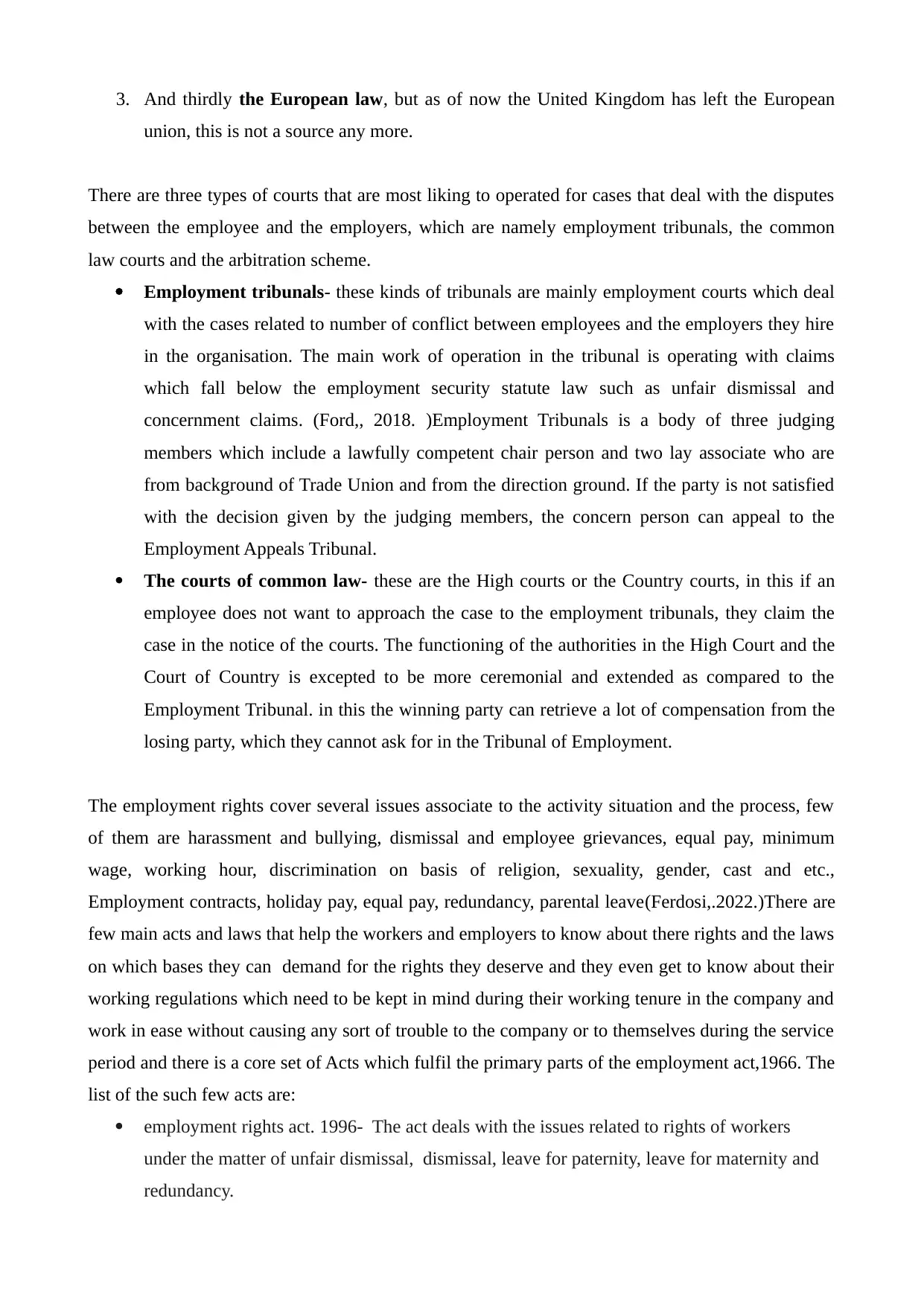
3. And thirdly the European law, but as of now the United Kingdom has left the European
union, this is not a source any more.
There are three types of courts that are most liking to operated for cases that deal with the disputes
between the employee and the employers, which are namely employment tribunals, the common
law courts and the arbitration scheme.
Employment tribunals- these kinds of tribunals are mainly employment courts which deal
with the cases related to number of conflict between employees and the employers they hire
in the organisation. The main work of operation in the tribunal is operating with claims
which fall below the employment security statute law such as unfair dismissal and
concernment claims. (Ford,, 2018. )Employment Tribunals is a body of three judging
members which include a lawfully competent chair person and two lay associate who are
from background of Trade Union and from the direction ground. If the party is not satisfied
with the decision given by the judging members, the concern person can appeal to the
Employment Appeals Tribunal.
The courts of common law- these are the High courts or the Country courts, in this if an
employee does not want to approach the case to the employment tribunals, they claim the
case in the notice of the courts. The functioning of the authorities in the High Court and the
Court of Country is excepted to be more ceremonial and extended as compared to the
Employment Tribunal. in this the winning party can retrieve a lot of compensation from the
losing party, which they cannot ask for in the Tribunal of Employment.
The employment rights cover several issues associate to the activity situation and the process, few
of them are harassment and bullying, dismissal and employee grievances, equal pay, minimum
wage, working hour, discrimination on basis of religion, sexuality, gender, cast and etc.,
Employment contracts, holiday pay, equal pay, redundancy, parental leave(Ferdosi,.2022.)There are
few main acts and laws that help the workers and employers to know about there rights and the laws
on which bases they can demand for the rights they deserve and they even get to know about their
working regulations which need to be kept in mind during their working tenure in the company and
work in ease without causing any sort of trouble to the company or to themselves during the service
period and there is a core set of Acts which fulfil the primary parts of the employment act,1966. The
list of the such few acts are:
employment rights act. 1996- The act deals with the issues related to rights of workers
under the matter of unfair dismissal, dismissal, leave for paternity, leave for maternity and
redundancy.
union, this is not a source any more.
There are three types of courts that are most liking to operated for cases that deal with the disputes
between the employee and the employers, which are namely employment tribunals, the common
law courts and the arbitration scheme.
Employment tribunals- these kinds of tribunals are mainly employment courts which deal
with the cases related to number of conflict between employees and the employers they hire
in the organisation. The main work of operation in the tribunal is operating with claims
which fall below the employment security statute law such as unfair dismissal and
concernment claims. (Ford,, 2018. )Employment Tribunals is a body of three judging
members which include a lawfully competent chair person and two lay associate who are
from background of Trade Union and from the direction ground. If the party is not satisfied
with the decision given by the judging members, the concern person can appeal to the
Employment Appeals Tribunal.
The courts of common law- these are the High courts or the Country courts, in this if an
employee does not want to approach the case to the employment tribunals, they claim the
case in the notice of the courts. The functioning of the authorities in the High Court and the
Court of Country is excepted to be more ceremonial and extended as compared to the
Employment Tribunal. in this the winning party can retrieve a lot of compensation from the
losing party, which they cannot ask for in the Tribunal of Employment.
The employment rights cover several issues associate to the activity situation and the process, few
of them are harassment and bullying, dismissal and employee grievances, equal pay, minimum
wage, working hour, discrimination on basis of religion, sexuality, gender, cast and etc.,
Employment contracts, holiday pay, equal pay, redundancy, parental leave(Ferdosi,.2022.)There are
few main acts and laws that help the workers and employers to know about there rights and the laws
on which bases they can demand for the rights they deserve and they even get to know about their
working regulations which need to be kept in mind during their working tenure in the company and
work in ease without causing any sort of trouble to the company or to themselves during the service
period and there is a core set of Acts which fulfil the primary parts of the employment act,1966. The
list of the such few acts are:
employment rights act. 1996- The act deals with the issues related to rights of workers
under the matter of unfair dismissal, dismissal, leave for paternity, leave for maternity and
redundancy.
Paraphrase This Document
Need a fresh take? Get an instant paraphrase of this document with our AI Paraphraser
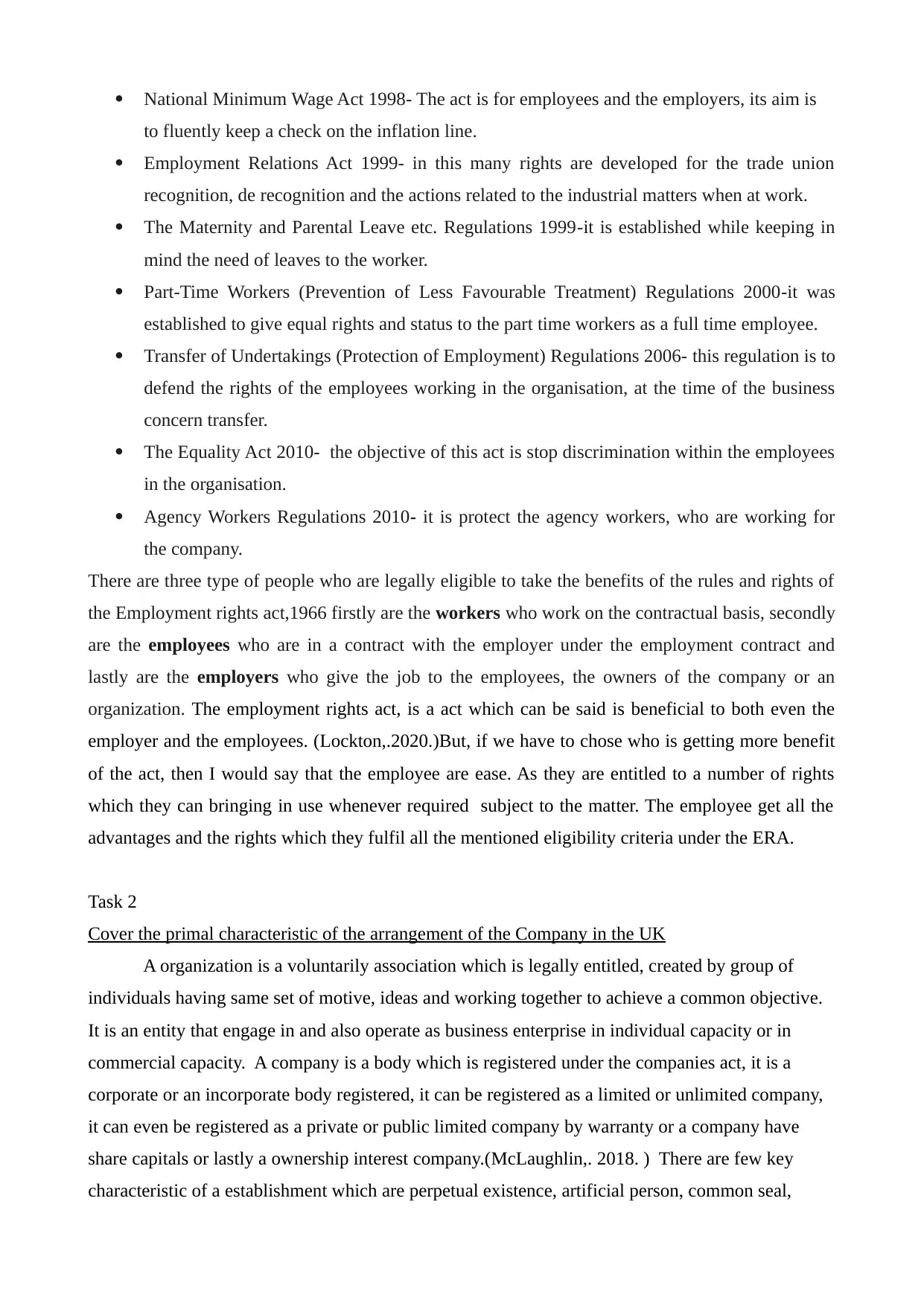
National Minimum Wage Act 1998- The act is for employees and the employers, its aim is
to fluently keep a check on the inflation line.
Employment Relations Act 1999- in this many rights are developed for the trade union
recognition, de recognition and the actions related to the industrial matters when at work.
The Maternity and Parental Leave etc. Regulations 1999-it is established while keeping in
mind the need of leaves to the worker.
Part-Time Workers (Prevention of Less Favourable Treatment) Regulations 2000-it was
established to give equal rights and status to the part time workers as a full time employee.
Transfer of Undertakings (Protection of Employment) Regulations 2006- this regulation is to
defend the rights of the employees working in the organisation, at the time of the business
concern transfer.
The Equality Act 2010- the objective of this act is stop discrimination within the employees
in the organisation.
Agency Workers Regulations 2010- it is protect the agency workers, who are working for
the company.
There are three type of people who are legally eligible to take the benefits of the rules and rights of
the Employment rights act,1966 firstly are the workers who work on the contractual basis, secondly
are the employees who are in a contract with the employer under the employment contract and
lastly are the employers who give the job to the employees, the owners of the company or an
organization. The employment rights act, is a act which can be said is beneficial to both even the
employer and the employees. (Lockton,.2020.)But, if we have to chose who is getting more benefit
of the act, then I would say that the employee are ease. As they are entitled to a number of rights
which they can bringing in use whenever required subject to the matter. The employee get all the
advantages and the rights which they fulfil all the mentioned eligibility criteria under the ERA.
Task 2
Cover the primal characteristic of the arrangement of the Company in the UK
A organization is a voluntarily association which is legally entitled, created by group of
individuals having same set of motive, ideas and working together to achieve a common objective.
It is an entity that engage in and also operate as business enterprise in individual capacity or in
commercial capacity. A company is a body which is registered under the companies act, it is a
corporate or an incorporate body registered, it can be registered as a limited or unlimited company,
it can even be registered as a private or public limited company by warranty or a company have
share capitals or lastly a ownership interest company.(McLaughlin,. 2018. ) There are few key
characteristic of a establishment which are perpetual existence, artificial person, common seal,
to fluently keep a check on the inflation line.
Employment Relations Act 1999- in this many rights are developed for the trade union
recognition, de recognition and the actions related to the industrial matters when at work.
The Maternity and Parental Leave etc. Regulations 1999-it is established while keeping in
mind the need of leaves to the worker.
Part-Time Workers (Prevention of Less Favourable Treatment) Regulations 2000-it was
established to give equal rights and status to the part time workers as a full time employee.
Transfer of Undertakings (Protection of Employment) Regulations 2006- this regulation is to
defend the rights of the employees working in the organisation, at the time of the business
concern transfer.
The Equality Act 2010- the objective of this act is stop discrimination within the employees
in the organisation.
Agency Workers Regulations 2010- it is protect the agency workers, who are working for
the company.
There are three type of people who are legally eligible to take the benefits of the rules and rights of
the Employment rights act,1966 firstly are the workers who work on the contractual basis, secondly
are the employees who are in a contract with the employer under the employment contract and
lastly are the employers who give the job to the employees, the owners of the company or an
organization. The employment rights act, is a act which can be said is beneficial to both even the
employer and the employees. (Lockton,.2020.)But, if we have to chose who is getting more benefit
of the act, then I would say that the employee are ease. As they are entitled to a number of rights
which they can bringing in use whenever required subject to the matter. The employee get all the
advantages and the rights which they fulfil all the mentioned eligibility criteria under the ERA.
Task 2
Cover the primal characteristic of the arrangement of the Company in the UK
A organization is a voluntarily association which is legally entitled, created by group of
individuals having same set of motive, ideas and working together to achieve a common objective.
It is an entity that engage in and also operate as business enterprise in individual capacity or in
commercial capacity. A company is a body which is registered under the companies act, it is a
corporate or an incorporate body registered, it can be registered as a limited or unlimited company,
it can even be registered as a private or public limited company by warranty or a company have
share capitals or lastly a ownership interest company.(McLaughlin,. 2018. ) There are few key
characteristic of a establishment which are perpetual existence, artificial person, common seal,
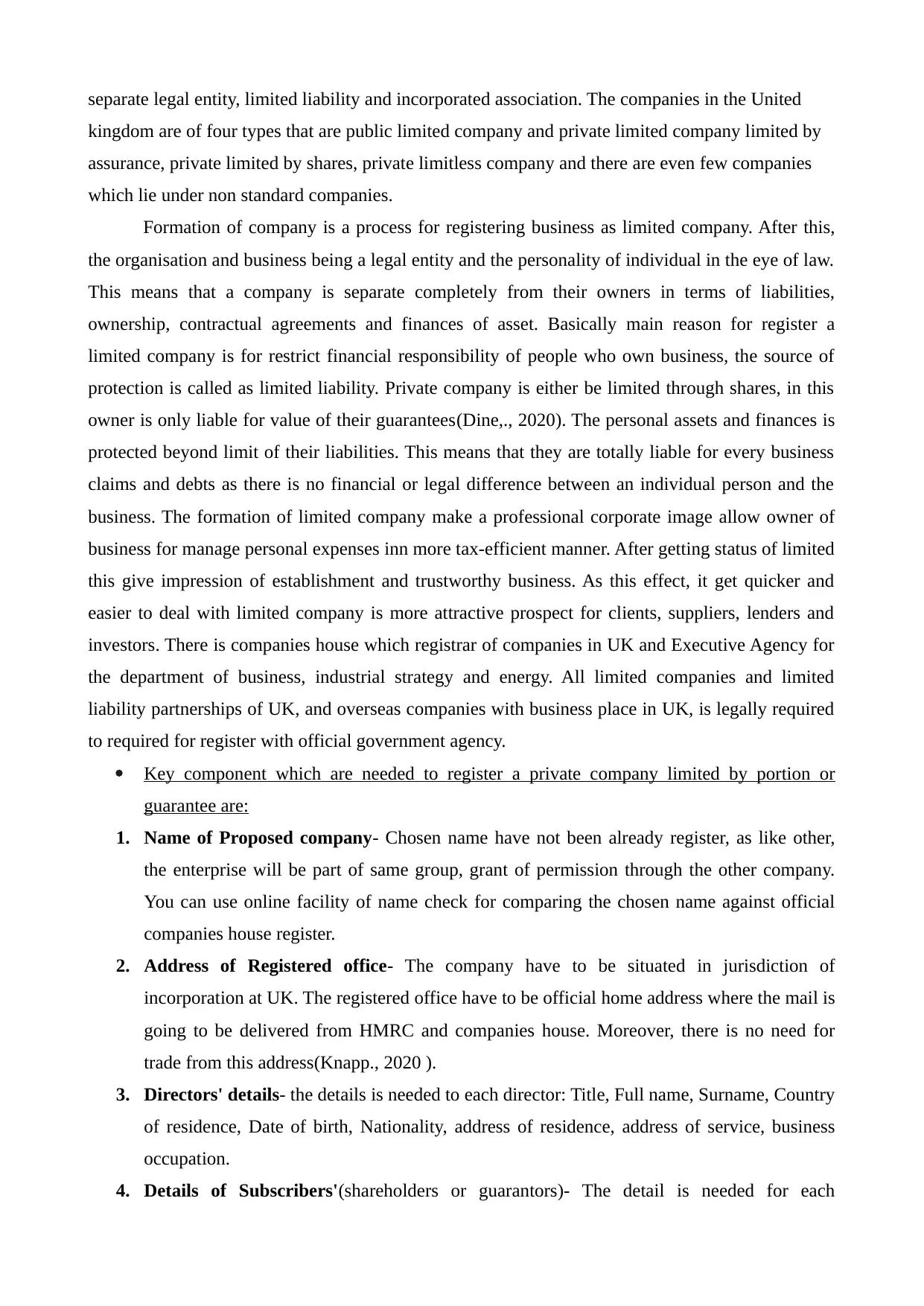
separate legal entity, limited liability and incorporated association. The companies in the United
kingdom are of four types that are public limited company and private limited company limited by
assurance, private limited by shares, private limitless company and there are even few companies
which lie under non standard companies.
Formation of company is a process for registering business as limited company. After this,
the organisation and business being a legal entity and the personality of individual in the eye of law.
This means that a company is separate completely from their owners in terms of liabilities,
ownership, contractual agreements and finances of asset. Basically main reason for register a
limited company is for restrict financial responsibility of people who own business, the source of
protection is called as limited liability. Private company is either be limited through shares, in this
owner is only liable for value of their guarantees(Dine,., 2020). The personal assets and finances is
protected beyond limit of their liabilities. This means that they are totally liable for every business
claims and debts as there is no financial or legal difference between an individual person and the
business. The formation of limited company make a professional corporate image allow owner of
business for manage personal expenses inn more tax-efficient manner. After getting status of limited
this give impression of establishment and trustworthy business. As this effect, it get quicker and
easier to deal with limited company is more attractive prospect for clients, suppliers, lenders and
investors. There is companies house which registrar of companies in UK and Executive Agency for
the department of business, industrial strategy and energy. All limited companies and limited
liability partnerships of UK, and overseas companies with business place in UK, is legally required
to required for register with official government agency.
Key component which are needed to register a private company limited by portion or
guarantee are:
1. Name of Proposed company- Chosen name have not been already register, as like other,
the enterprise will be part of same group, grant of permission through the other company.
You can use online facility of name check for comparing the chosen name against official
companies house register.
2. Address of Registered office- The company have to be situated in jurisdiction of
incorporation at UK. The registered office have to be official home address where the mail is
going to be delivered from HMRC and companies house. Moreover, there is no need for
trade from this address(Knapp., 2020 ).
3. Directors' details- the details is needed to each director: Title, Full name, Surname, Country
of residence, Date of birth, Nationality, address of residence, address of service, business
occupation.
4. Details of Subscribers'(shareholders or guarantors)- The detail is needed for each
kingdom are of four types that are public limited company and private limited company limited by
assurance, private limited by shares, private limitless company and there are even few companies
which lie under non standard companies.
Formation of company is a process for registering business as limited company. After this,
the organisation and business being a legal entity and the personality of individual in the eye of law.
This means that a company is separate completely from their owners in terms of liabilities,
ownership, contractual agreements and finances of asset. Basically main reason for register a
limited company is for restrict financial responsibility of people who own business, the source of
protection is called as limited liability. Private company is either be limited through shares, in this
owner is only liable for value of their guarantees(Dine,., 2020). The personal assets and finances is
protected beyond limit of their liabilities. This means that they are totally liable for every business
claims and debts as there is no financial or legal difference between an individual person and the
business. The formation of limited company make a professional corporate image allow owner of
business for manage personal expenses inn more tax-efficient manner. After getting status of limited
this give impression of establishment and trustworthy business. As this effect, it get quicker and
easier to deal with limited company is more attractive prospect for clients, suppliers, lenders and
investors. There is companies house which registrar of companies in UK and Executive Agency for
the department of business, industrial strategy and energy. All limited companies and limited
liability partnerships of UK, and overseas companies with business place in UK, is legally required
to required for register with official government agency.
Key component which are needed to register a private company limited by portion or
guarantee are:
1. Name of Proposed company- Chosen name have not been already register, as like other,
the enterprise will be part of same group, grant of permission through the other company.
You can use online facility of name check for comparing the chosen name against official
companies house register.
2. Address of Registered office- The company have to be situated in jurisdiction of
incorporation at UK. The registered office have to be official home address where the mail is
going to be delivered from HMRC and companies house. Moreover, there is no need for
trade from this address(Knapp., 2020 ).
3. Directors' details- the details is needed to each director: Title, Full name, Surname, Country
of residence, Date of birth, Nationality, address of residence, address of service, business
occupation.
4. Details of Subscribers'(shareholders or guarantors)- The detail is needed for each
⊘ This is a preview!⊘
Do you want full access?
Subscribe today to unlock all pages.

Trusted by 1+ million students worldwide
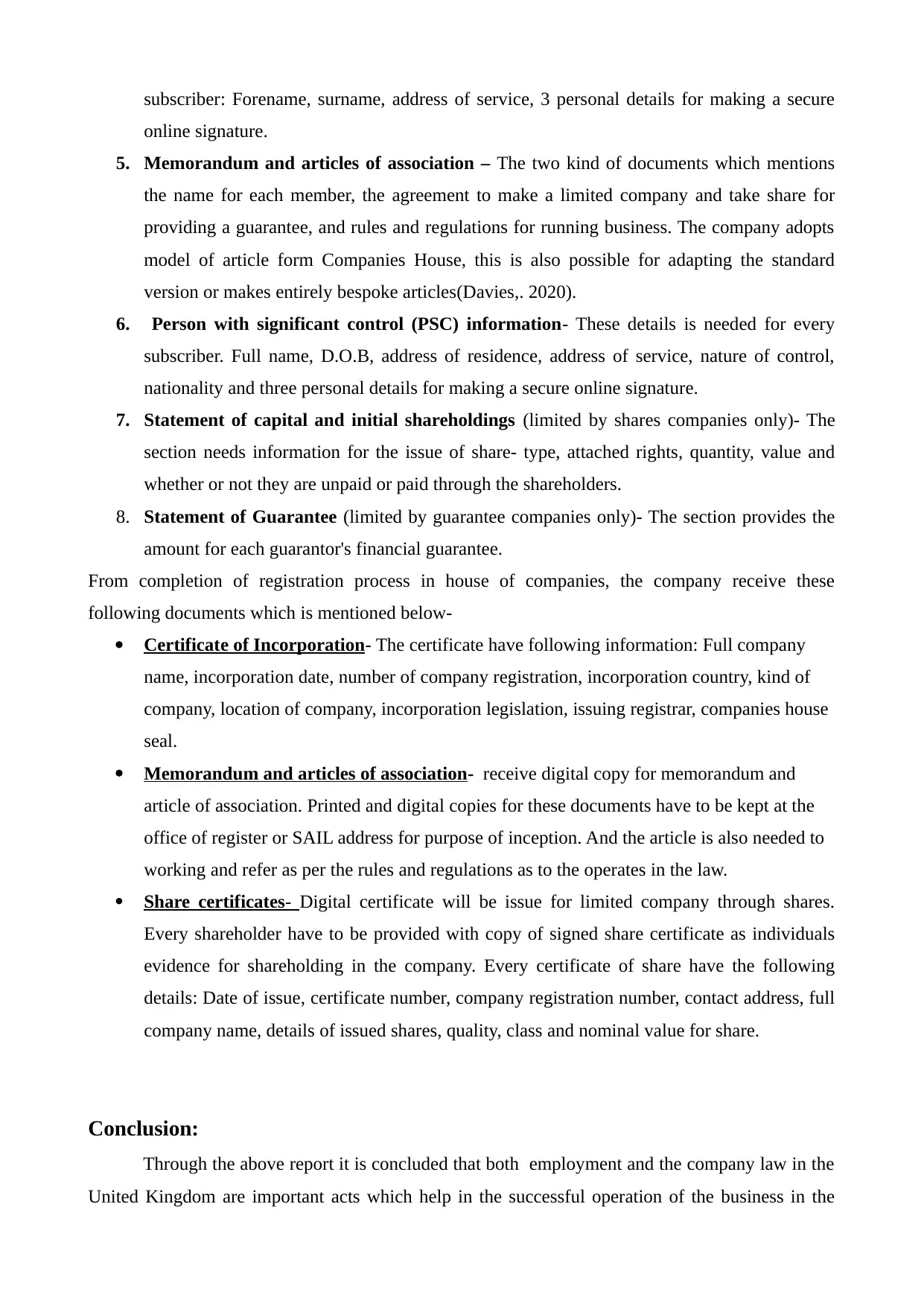
subscriber: Forename, surname, address of service, 3 personal details for making a secure
online signature.
5. Memorandum and articles of association – The two kind of documents which mentions
the name for each member, the agreement to make a limited company and take share for
providing a guarantee, and rules and regulations for running business. The company adopts
model of article form Companies House, this is also possible for adapting the standard
version or makes entirely bespoke articles(Davies,. 2020).
6. Person with significant control (PSC) information- These details is needed for every
subscriber. Full name, D.O.B, address of residence, address of service, nature of control,
nationality and three personal details for making a secure online signature.
7. Statement of capital and initial shareholdings (limited by shares companies only)- The
section needs information for the issue of share- type, attached rights, quantity, value and
whether or not they are unpaid or paid through the shareholders.
8. Statement of Guarantee (limited by guarantee companies only)- The section provides the
amount for each guarantor's financial guarantee.
From completion of registration process in house of companies, the company receive these
following documents which is mentioned below-
Certificate of Incorporation- The certificate have following information: Full company
name, incorporation date, number of company registration, incorporation country, kind of
company, location of company, incorporation legislation, issuing registrar, companies house
seal.
Memorandum and articles of association- receive digital copy for memorandum and
article of association. Printed and digital copies for these documents have to be kept at the
office of register or SAIL address for purpose of inception. And the article is also needed to
working and refer as per the rules and regulations as to the operates in the law.
Share certificates- Digital certificate will be issue for limited company through shares.
Every shareholder have to be provided with copy of signed share certificate as individuals
evidence for shareholding in the company. Every certificate of share have the following
details: Date of issue, certificate number, company registration number, contact address, full
company name, details of issued shares, quality, class and nominal value for share.
Conclusion:
Through the above report it is concluded that both employment and the company law in the
United Kingdom are important acts which help in the successful operation of the business in the
online signature.
5. Memorandum and articles of association – The two kind of documents which mentions
the name for each member, the agreement to make a limited company and take share for
providing a guarantee, and rules and regulations for running business. The company adopts
model of article form Companies House, this is also possible for adapting the standard
version or makes entirely bespoke articles(Davies,. 2020).
6. Person with significant control (PSC) information- These details is needed for every
subscriber. Full name, D.O.B, address of residence, address of service, nature of control,
nationality and three personal details for making a secure online signature.
7. Statement of capital and initial shareholdings (limited by shares companies only)- The
section needs information for the issue of share- type, attached rights, quantity, value and
whether or not they are unpaid or paid through the shareholders.
8. Statement of Guarantee (limited by guarantee companies only)- The section provides the
amount for each guarantor's financial guarantee.
From completion of registration process in house of companies, the company receive these
following documents which is mentioned below-
Certificate of Incorporation- The certificate have following information: Full company
name, incorporation date, number of company registration, incorporation country, kind of
company, location of company, incorporation legislation, issuing registrar, companies house
seal.
Memorandum and articles of association- receive digital copy for memorandum and
article of association. Printed and digital copies for these documents have to be kept at the
office of register or SAIL address for purpose of inception. And the article is also needed to
working and refer as per the rules and regulations as to the operates in the law.
Share certificates- Digital certificate will be issue for limited company through shares.
Every shareholder have to be provided with copy of signed share certificate as individuals
evidence for shareholding in the company. Every certificate of share have the following
details: Date of issue, certificate number, company registration number, contact address, full
company name, details of issued shares, quality, class and nominal value for share.
Conclusion:
Through the above report it is concluded that both employment and the company law in the
United Kingdom are important acts which help in the successful operation of the business in the
Paraphrase This Document
Need a fresh take? Get an instant paraphrase of this document with our AI Paraphraser
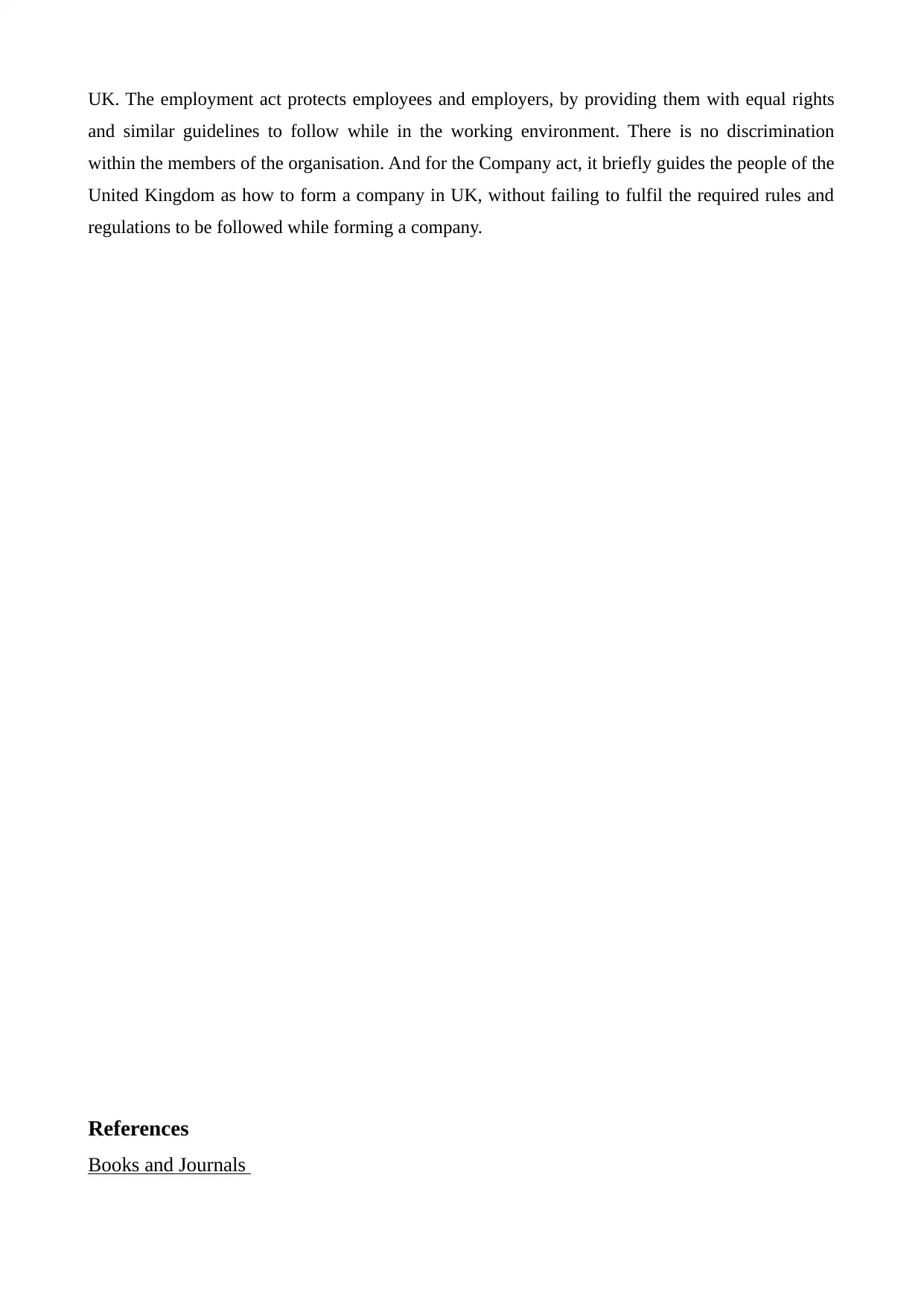
UK. The employment act protects employees and employers, by providing them with equal rights
and similar guidelines to follow while in the working environment. There is no discrimination
within the members of the organisation. And for the Company act, it briefly guides the people of the
United Kingdom as how to form a company in UK, without failing to fulfil the required rules and
regulations to be followed while forming a company.
References
Books and Journals
and similar guidelines to follow while in the working environment. There is no discrimination
within the members of the organisation. And for the Company act, it briefly guides the people of the
United Kingdom as how to form a company in UK, without failing to fulfil the required rules and
regulations to be followed while forming a company.
References
Books and Journals
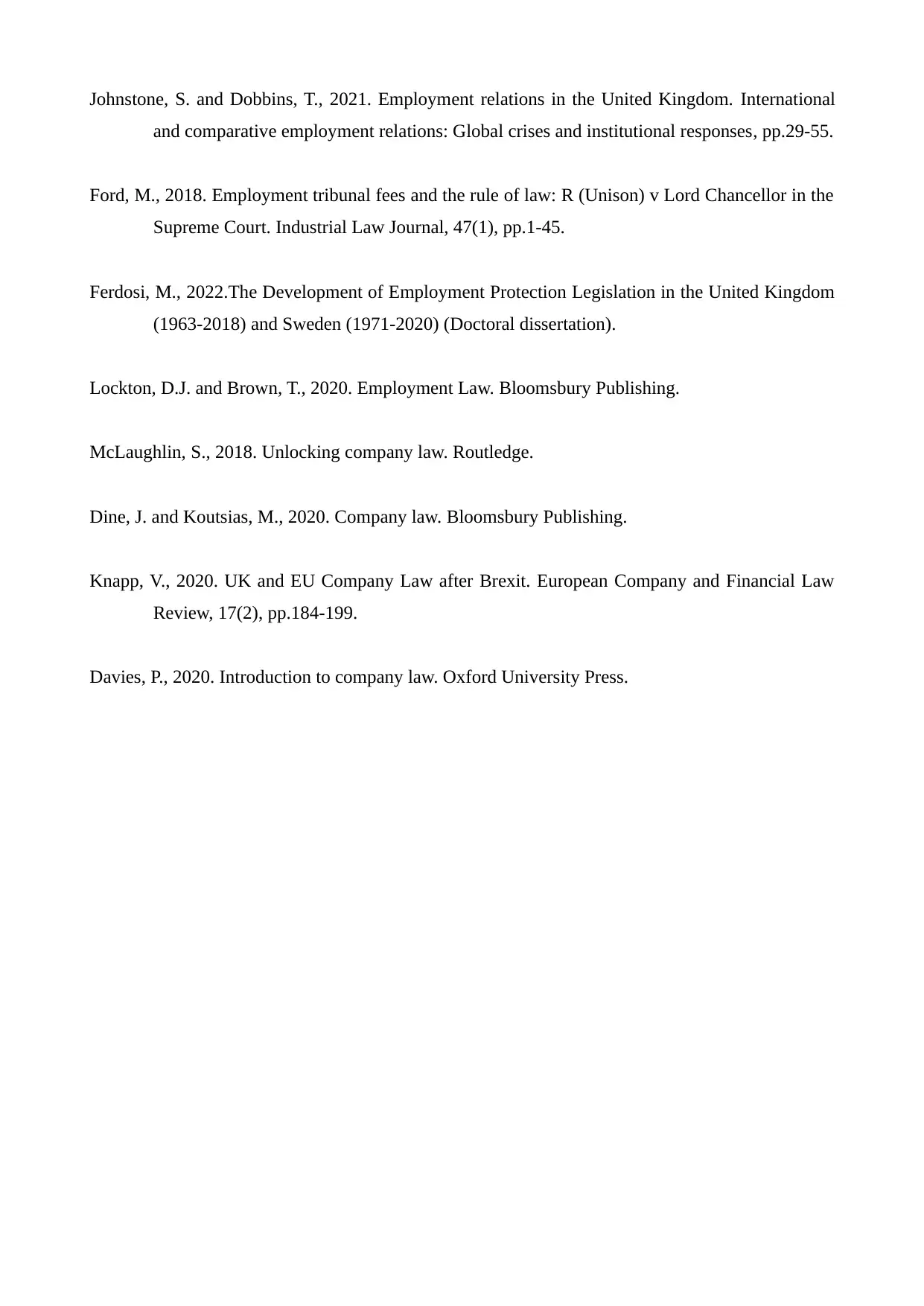
Johnstone, S. and Dobbins, T., 2021. Employment relations in the United Kingdom. International
and comparative employment relations: Global crises and institutional responses, pp.29-55.
Ford, M., 2018. Employment tribunal fees and the rule of law: R (Unison) v Lord Chancellor in the
Supreme Court. Industrial Law Journal, 47(1), pp.1-45.
Ferdosi, M., 2022.The Development of Employment Protection Legislation in the United Kingdom
(1963-2018) and Sweden (1971-2020) (Doctoral dissertation).
Lockton, D.J. and Brown, T., 2020. Employment Law. Bloomsbury Publishing.
McLaughlin, S., 2018. Unlocking company law. Routledge.
Dine, J. and Koutsias, M., 2020. Company law. Bloomsbury Publishing.
Knapp, V., 2020. UK and EU Company Law after Brexit. European Company and Financial Law
Review, 17(2), pp.184-199.
Davies, P., 2020. Introduction to company law. Oxford University Press.
and comparative employment relations: Global crises and institutional responses, pp.29-55.
Ford, M., 2018. Employment tribunal fees and the rule of law: R (Unison) v Lord Chancellor in the
Supreme Court. Industrial Law Journal, 47(1), pp.1-45.
Ferdosi, M., 2022.The Development of Employment Protection Legislation in the United Kingdom
(1963-2018) and Sweden (1971-2020) (Doctoral dissertation).
Lockton, D.J. and Brown, T., 2020. Employment Law. Bloomsbury Publishing.
McLaughlin, S., 2018. Unlocking company law. Routledge.
Dine, J. and Koutsias, M., 2020. Company law. Bloomsbury Publishing.
Knapp, V., 2020. UK and EU Company Law after Brexit. European Company and Financial Law
Review, 17(2), pp.184-199.
Davies, P., 2020. Introduction to company law. Oxford University Press.
⊘ This is a preview!⊘
Do you want full access?
Subscribe today to unlock all pages.

Trusted by 1+ million students worldwide
1 out of 9
Related Documents
Your All-in-One AI-Powered Toolkit for Academic Success.
+13062052269
info@desklib.com
Available 24*7 on WhatsApp / Email
![[object Object]](/_next/static/media/star-bottom.7253800d.svg)
Unlock your academic potential
© 2024 | Zucol Services PVT LTD | All rights reserved.



